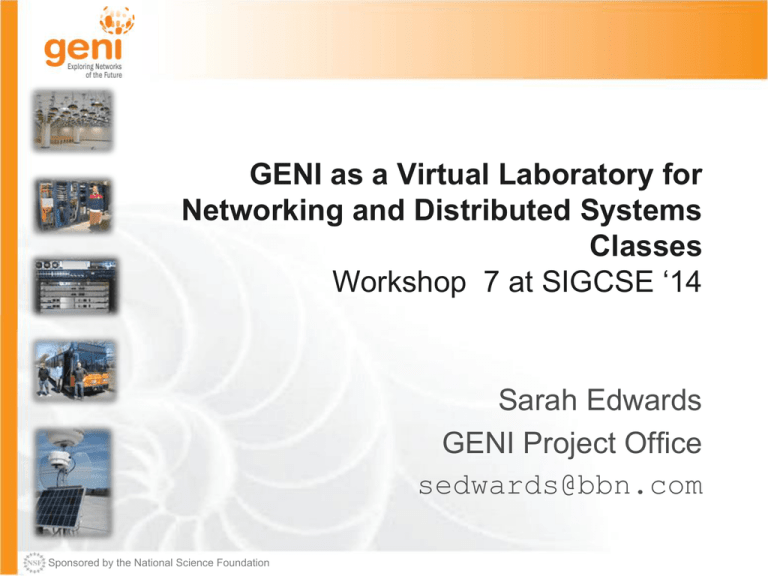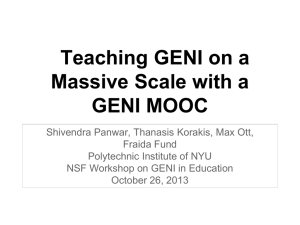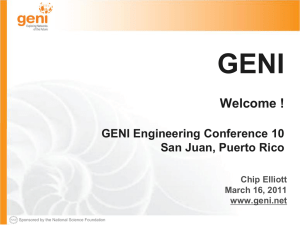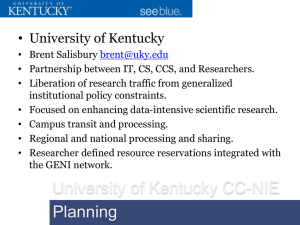Document
advertisement

GENI as a Virtual Laboratory for Networking and Distributed Systems Classes Workshop 7 at SIGCSE ‘14 Sarah Edwards GENI Project Office sedwards@bbn.com Sponsored by the National Science Foundation Agenda Presentation and Demo: An Introduction to GENI (45min) Hands-on: Getting Started with GENI (45min) Break (10min) Hands-on: IPv4 Routing Assignment (50min) Resources for Instructors (15min) Miscellaneous GENI Topics & Wrap-Up (15min) Sponsored by the National Science Foundation GENI Introduction – SIGCSE ‘14 – 5 March 2014 www.geni.net 2 GENI Exploring Networks of the Future www.geni.net Sponsored by the National Science Foundation Outline • • • • • • GENI – Exploring future internets at scale The GENI Concept Building GENI Experimental and Classroom use of GENI What’s next for GENI? GENI: An experimenter’s view Sponsored by the National Science Foundation GENI Introduction – SIGCSE ‘14 – 5 March 2014 www.geni.net 4 Global networks are creating extremely important new challenges Science Issues We cannot currently understand or predict the behavior of complex, large-scale networks Innovation Issues Substantial barriers to at-scale experimentation with new architectures, services, and technologies Society Issues Credit: MONET Group at UIUC We increasingly rely on the Internet but are unsure we can trust its security, privacy or resilience Sponsored by the National Science Foundation GENI Introduction – SIGCSE ‘14 – 5 March 2014 www.geni.net 5 GENI: Infrastructure for Experimentation GENI provides compute resources that can be connected in experimenter specified Layer 2 topologies. Sponsored by the National Science Foundation GENI Introduction – SIGCSE ‘14 – 5 March 2014 www.geni.net 6 GENI: Infrastructure for Experimentation GENI provides compute resources that can be connected in experimenter specified Layer 2 topologies. Sponsored by the National Science Foundation GENI Introduction – SIGCSE ‘14 – 5 March 2014 www.geni.net 7 Multiple GENI Experiments run Concurrently Infrastructure can be shared between slices Experiments live in isolated “slices” Sponsored by the National Science Foundation GENI Introduction – SIGCSE ‘14 – 5 March 2014 www.geni.net 8 GENI is “Deeply Programmable” I install software I want throughout my network slice (into routers, switches, …) or control switches using OpenFlow Experimenters can set up custom topologies, protocols and switching of flows Sponsored by the National Science Foundation GENI Introduction – SIGCSE ‘14 – 5 March 2014 www.geni.net 9 GENI Compute Resources GENI Wireless compute nodes GENI Racks Existing Testbeds (e.g. Emulab) Sponsored by the National Science Foundation GENI Introduction – SIGCSE ‘14 – 5 March 2014 www.geni.net 10 GENI Networking Resources Networking within a Rack National Research Backbones (e.g. Internet2) Regional Networks (e.g. CENIC) WiMAX Base Stations Sponsored by the National Science Foundation GENI Introduction – SIGCSE ‘14 – 5 March 2014 www.geni.net 11 Outline • • • • • GENI – Exploring future internets at scale The GENI Concept Building GENI Experimental and Classroom use of GENI GENI: An experimenter’s view Sponsored by the National Science Foundation GENI Introduction – SIGCSE ‘14 – 5 March 2014 www.geni.net 12 A bright idea “I have a great idea.” “That will never work.” Sponsored by the National Science Foundation GENI Introduction – SIGCSE ‘14 – 5 March 2014 www.geni.net 13 Let’s try it out! My new architecture worked great in the lab, so now I’m going to try a larger experiment for a few months. He uses a modest slice of GENI, sharing its infrastructure with many other concurrent experiments. Sponsored by the National Science Foundation GENI Introduction – SIGCSE ‘14 – 5 March 2014 www.geni.net 14 It turns into a really good idea This service looks very useful His slice of GENI keeps growing, but GENI is still running many other concurrent experiments. Sponsored by the National Science Foundation GENI Introduction – SIGCSE ‘14 – 5 March 2014 www.geni.net 15 Attracts real users “Looks like an app to me.” “It’s my very own GENI slice.” Sponsored by the National Science Foundation GENI Introduction – SIGCSE ‘14 – 5 March 2014 www.geni.net 16 “Boy did I learn a lot!” “What a cool service.” (I wonder how it works.) “I always said it was a great idea.” (But way too conservative.) Sponsored by the National Science Foundation GENI Introduction – SIGCSE ‘14 – 5 March 2014 www.geni.net 17 ?? If you have a great idea, check out the NSF CISE research programs for current opportunities. Sponsored by the National Science Foundation GENI Introduction – SIGCSE ‘14 – 5 March 2014 www.geni.net 18 Moral of this story GENI is meant to enable . . . – At-scale experiments – Internet-incompatible experiments – Both repeatable and “in the wild” experiments – ‘Opt in’ for real users – Instrumentation and measurement tools GENI creates a huge opportunity for ambitious research! Sponsored by the National Science Foundation GENI Introduction – SIGCSE ‘14 – 5 March 2014 www.geni.net 19 Outline • • • • • GENI – Exploring future internets at scale The GENI Concept Building GENI Experimental and Classroom use of GENI GENI: An experimenter’s view Sponsored by the National Science Foundation GENI Introduction – SIGCSE ‘14 – 5 March 2014 www.geni.net 20 Growing GENI’s footprint Sponsored by the National Science Foundation GENI Introduction – SIGCSE ‘14 – 5 March 2014 www.geni.net 21 Federation GENI grows by GENI-enabling heterogeneous infrastructure My experiment runs across the evolving GENI federation. GENI Rack Commercial Clouds Backbone #1 Campus My GENI Slice Access #1 Research Testbed Corporate GENI suites Regional Non-US Testbeds This approach looks remarkably familiar . . . GENI Rack Avoid technology “lock in” and grow quickly by incorporating existing infrastructure Sponsored by the National Science Foundation GENI Introduction – SIGCSE ‘14 – 5 March 2014 www.geni.net 22 Federation Extends the Reach of GENI and International Peer Testbeds Initial plan to federate testbeds on five continents Sponsored by the National Science Foundation GENI Introduction – SIGCSE ‘14 – 5 March 2014 www.geni.net 23 Build GENI at sufficient scale Infeasible to build a testbed as big as the Internet HP ProCurve 5400 Switch NEC WiMAX Base Station GENI-enabled equipment GENI-enabled campuses, students as early adopters “At scale” GENI prototype GENI-enable testbeds, commercial equipment, campuses, regional and backbone networks Campus photo by Vonbloompasha Sponsored by the National Science Foundation GENI Introduction – SIGCSE ‘14 – 5 March 2014 www.geni.net 24 GENI architecture UNI VERSI T Y ISP Internet Metro Research Backbones g GENI-enabled hardware Legend Layer 2 Data Plane Layer 3 Control Plane g UNI VERSI T Y Regional Networks Campus g • Flexible network / cloud research • Support “hybrid circuit” model plus infrastructure much more (OpenFlow) • Also suitable for physics, • Distributed cloud (racks) for content genomics, other domain science caching, acceleration, etc. Sponsored by the National Science Foundation GENI Introduction – SIGCSE ‘14 – 5 March 2014 www.geni.net 25 Creating and deploying GENI racks Ilia Baldine RENCI More resources / rack, fewer racks Rick McGeer Fewer resources / rack, more racks GENI Rack Installed at GPO – Feb 22, 2012 Sponsored by the National Science Foundation GENI Introduction – SIGCSE ‘14 – 5 March 2014 www.geni.net 26 GENI WiMAX 2013 • 26 Wimax Base Stations in 13 Sites • Sliced, virtualized and interconnected Sponsored by the National Science Foundation On the Air Not On the Air • Researcher-owned, • researcher-operated • 4G cellular systems GENI Introduction – SIGCSE ‘14 – 5 March 2014 www.geni.net 27 GENI WiMAX Agreements • Agreement with Clearwire – Clearwire and Rutgers University have signed a master agreement – encompassing all WiMAX sites, to ensure operation in the EBS Band. – An emergency stop procedure, in case of interference with Clearwire service, has been agreed upon. • GENI Mobile Virtual Network Operator (MVNO) - Partner with Sprint and Arterra (a Sprint partner) to create and operate an (MVNO) that serves the academic research community - The effort is led by Jim Martin, Clemson Univ, and is underway with a 1 year NSF EAGER Agreements in place to broadcast on our own frequency and to support roaming Sponsored by the National Science Foundation GENI Introduction – SIGCSE ‘14 – 5 March 2014 www.geni.net 28 GENI Operations GMOC: GENI Meta-operation Center • Keeps track of outages • Notification system for resource reservation • Monitors most GENI Aggregates GMOC Google Calendar keeps track of reservations/outages Sponsored by the National Science Foundation GENI Introduction – SIGCSE ‘14 – 5 March 2014 www.geni.net 29 Outline • • • • • GENI – Exploring future internets at scale The GENI Concept Building GENI Experimental and Classroom use of GENI GENI: An experimenter’s view Sponsored by the National Science Foundation GENI Introduction – SIGCSE ‘14 – 5 March 2014 www.geni.net 30 How is GENI being Used? Research • Future Internet Architectures • Software defined networking • Large scale evaluation of protocols Education • Networking and Distributed systems classes • Cloud computing classes • WiMAX classes As of October 2013, GENI had over 1200 users! Sponsored by the National Science Foundation GENI Introduction – SIGCSE ‘14 – 5 March 2014 www.geni.net 31 Three FIA Teams have Slices on GENI NDN (demo at GEC 13) XIA (demo at GEC15) MobilityFirst (demo at GEC 12 & GEC18) GENI is the only testbed that can support these teams. Sponsored by the National Science Foundation GENI Introduction – SIGCSE ‘14 – 5 March 2014 www.geni.net 32 Virtual Desktop Cloud Prasad Calyam, University of Missouri, Columbia Program realtime loadbalancing functionality deep into the network to improve QoE Sponsored by the National Science Foundation GENI Introduction – SIGCSE ‘14 – 5 March 2014 www.geni.net 33 GENI in the Classroom – A great success! Fall 2013: Prasad Calyam (U. of Missouri) Zongming Fei (U. of KY) John Geske (Kettering U.) Deniz Gurkan (U. of Houston) Christos Papadopoulos (Col. State) Violet Syrotiuk (Arizona State U.) Zhi-Li Zhang (U. of MN) Jeannie Albrecht (Williams College) with students from her Spring 2012 Distributed Systems class Spring 2013: Jay Aikat (U. of NC) Rudra Dutta (NCSU) Khaled Harfoush (NCSU) Jelena Marasevic (Columbia U) Parmesh Ramanathan (U. Wisc) Violet Syrotiuk (Arizona State U.) KC Wang (Clemson) Michael Zink (U. of MA) Spring 2014: Jeannie Albrecht (Williams College) Suman Banerjee (U. of Wisconsin) Deniz Gurkan (U. of Houston) Thanasis Korakis (NYU Poly) Yaoqing Liu (Clarkson U) Shivendra Panwar (NYU Poly) Robert Ricci (Utah) Fall 2012: Violet Syrotiuk (Arizona State U) Rudra Dutta (NCSU) Bing Wang (U. of Conn) Zongming Fei (U. of KY) KC Wang (Clemson) Fraida Fund (NY Poly) Vasillis Maglaris (NTUA Greece) Kaiqi Xiong (RIT) Gaia Maselli (Sapienza University of Rome – Italy) Sponsored by the National Science Foundation GENI Introduction – SIGCSE ‘14 – 5 March 2014 www.geni.net 34 Upcoming GENI Events Tutorials at Conferences IC2E ‘14, etc GENI Summer Camp June ‘14 GEC19 Georgia Tech, Atlanta March 17-19, 2014 GENI Engineering Conferences, held three times a year Planning & discussion for experimenters, software, infrastructure Tutorials and workshops Travel grants to US academics for participant diversity Sponsored by the National Science Foundation Train-the-TA Offered online at the start of each semester GENI Introduction – SIGCSE ‘14 – 5 March 2014 www.geni.net 35 Outline • • • • • GENI – Exploring future internets at scale The GENI Concept Building GENI Experimental and Classroom use of GENI GENI: An experimenter’s view Sponsored by the National Science Foundation GENI Introduction – SIGCSE ‘14 – 5 March 2014 www.geni.net 36 Slice Slice Container for a collection of resources capable of running experiments – An experiment uses resources in a slice – Slices isolate experiments – Experimenters are responsible for their slices Sponsored by the National Science Foundation GENI Introduction – SIGCSE ‘14 – 5 March 2014 www.geni.net 37 Clearinghouse and Aggregates Create & Register Slice Slice credentials users projects slice s clearinghouse Aggregate Manager API Researcher Tool - listResources - createSliver … Aggregate Manager Aggregate Resources • Clearinghouse: Manages users, projects and slices – Standard credentials shared via custom API or new Common CH API – GENI supported accounts: GENI Portal/CH, PlanetLab CH, ProtoGENI CH • Aggregate: Provides resources to GENI experimenters – Typically owned and managed by an organization – Speaks the GENI AM API – Examples: PlanetLab, Emulab, GENI Racks on various campuses Sponsored by the National Science Foundation GENI Introduction – SIGCSE ‘14 – 5 March 2014 www.geni.net 38 Resource Specifications (Rspecs) • RSpecs: Lingua franca for describing and requesting resources – “Machine language” for negotiating resources between experiment and aggregate – Experimenter tools eliminate the need for most experimenters to write or read RSpec <?xml version="1.0" encoding="UTF-8"?> <rspec xmlns="http://www.protogeni.net/resources/rspec/2" xmlns:xsi="http://www.w3.org/2001/XMLSchema-instance" xsi:schemaLocation="http://www.protogeni.net/resources/rspec/2 http://www.protogeni.net/resources/rspec/2/request.xsd" type="request" > <node client_id="my-node" exclusive="true"> <sliver_type name="raw-pc" /> </node> RSpec for requesting a single node </rspec> Sponsored by the National Science Foundation GENI Introduction – SIGCSE ‘14 – 5 March 2014 www.geni.net 39 Reserving Resources using RSpecs and the AM API • • • • Experimenter tools and aggregates talk to each other using resource specifications (RSpecs) and the GENI Aggregate Manager API (GENI AM API) Advertisement RSpec: What does an aggregate have? Request RSpec: What does the experimenter want? Manifest RSpec: What does the experimenter have? What do you have? Experimenter Tool I would like … ListResources(…) Advertisement RSpec CreateSliver(Request RSpec, …) What do I have? You have Aggregate … Manager Manifest RSpec ListResources(SliceName, …) Manifest RSpec Sponsored by the National Science Foundation I have … GENI Introduction – SIGCSE ‘14 – 5 March 2014 You have … www.geni.net 40 Reserve resources across many aggregates in the same slice Campus #3 My slice contains resources from many aggregates. Commercial Clouds Backbone #1 Campus My GENI Slice Access #1 Research Testbed Corporate GENI suites Backbone #2 Other-Nation Projects Campus #2 One slice can contain: bare metal machines, virtual machines, VLANs, OpenFlow resources, etc Sponsored by the National Science Foundation GENI Introduction – SIGCSE ‘14 – 5 March 2014 www.geni.net 41 Putting it all Together: Demo • Demo – Login to the GENI Portal – Create a slice – Create a sliver at one aggregate server (VMs) client (VMs) • Two computers (VMs), connected by a LAN – Install and run software on the machines – View output of software – Delete sliver • Experimenter tool: Flack Sponsored by the National Science Foundation GENI Introduction – SIGCSE ‘14 – 5 March 2014 www.geni.net 42 Start Demo • • • • • • Login to GENI Experimenter Portal Create slice Launch Flack Draw topology Create sliver Verify sliver creation was successful Sponsored by the National Science Foundation GENI Introduction – SIGCSE ‘14 – 5 March 2014 www.geni.net 43 The Demo Experiment in Flack Sponsored by the National Science Foundation GENI Introduction – SIGCSE ‘14 – 5 March 2014 www.geni.net 44 The Request RSpec <rspec type="request” xsi:schemaLocation=“http://www.geni.net/resources/rspec/3 http://www.geni.net/resources/rspec/3/request.xsd” xmlns:xsi="http://www.w3.org/2001/XMLSchema-instance" xmlns="http://www.geni.net/resources/rspec/3"> <node client_id="server" component_manager_id="urn:publicid:IDN+emulab.net+authority+cm" exclusive="true"> <sliver_type name="raw-pc"> <disk_image name="urn:publicid:IDN+emulab.net+image+emulab-ops//FEDORA10-STD"/> </sliver_type> <services> <execute command="sudo /local/install-script.sh" shell="sh"/> <install install_path="/local" url="http://www.gpolab.bbn.com/experiment-support/HelloGENI//hellogeni-install.tar.gz"/> </services> <interface client_id="server:if0” /> </node> <node client_id="client" component_manager_id="urn:publicid:IDN+emulab.net+authority+cm" exclusive="false"> <sliver_type name="emulab-openvz"/> <services> <execute command="sudo /local/install-script.sh" shell="sh"/> <install install_path="/local" url="http://www.gpolab.bbn.com/experiment-support/HelloGENI//hellogeni-install.tar.gz"/> </services> <interface client_id="client:if0” /> </node> <link client_id="Lan"> <component_manager name="urn:publicid:IDN+emulab.net+authority+cm"/> <interface_ref client_id="server:if0"/> <interface_ref client_id="client:if0"/> <property source_id="server:if0" dest_id="client:if0"/> <property source_id="client:if0" dest_id="server:if0"/> </link> </rspec> Sponsored by the National Science Foundation GENI Introduction – SIGCSE ‘14 – 5 March 2014 www.geni.net 45 The Manifest RSpec <rspec type="manifest" …> <node client_id="server" component_manager_id="urn:publicid:IDN+emulab.net+authority+cm" exclusive="true" component_id="urn:publicid:IDN+emulab.net+node+pc554" sliver_id="urn:publicid:IDN+emulab.net+sliver+95506"> <sliver_type name="raw-pc"> <disk_image name="urn:publicid:IDN+emulab.net+image+emulab-ops//FEDORA10-STD"/> </sliver_type> <services> <execute command="sudo /local/install-script.sh" shell="sh"/> <install install_path="/local" url="http://www.gpolab.bbn.com/experiment-support/HelloGENI//hellogeni-install.tar.gz"/> <login authentication="ssh-keys" hostname="pc554.emulab.net" port="22" username="vthomas"/> </services> <interface client_id="server:if0" component_id="urn:publicid:IDN+emulab.net+interface+pc554:eth2" sliver_id="urn:publicid:IDN+emulab.net+sliver+95509" mac_address="0024e87a46fb"> <ip address="10.10.1.1" type="ipv4"/> </interface> </node> <node client_id="client" component_manager_id="urn:publicid:IDN+emulab.net+authority+cm" exclusive="false" component_id="urn:publicid:IDN+emulab.net+node+pc533" sliver_id="urn:publicid:IDN+emulab.net+sliver+95505"> <sliver_type name="emulab-openvz"/> <services> <execute command="sudo /local/install-script.sh" shell="sh"/> <install install_path="/local" url="http://www.gpolab.bbn.com/experiment-support/HelloGENI//hellogeni-install.tar.gz"/> <login authentication="ssh-keys" hostname="pc533.emulab.net" port="37178" username="vthomas"/> </services> <interface client_id="client:if0" component_id="urn:publicid:IDN+emulab.net+interface+pc533:eth2" sliver_id="urn:publicid:IDN+emulab.net+sliver+95510" mac_address="0262331adfd4"> <ip address="10.10.1.2" type="ipv4"/> </interface> </node> <link client_id="Lan" sliver_id="urn:publicid:IDN+emulab.net+sliver+95508" vlantag="310"> <interface_ref client_id="server:if0" component_id="urn:publicid:IDN+emulab.net+interface+pc554:eth2" sliver_id="urn:publicid:IDN+emulab.net+sliver+95509"/> <interface_ref client_id="client:if0" component_id="urn:publicid:IDN+emulab.net+interface+pc533:eth2" sliver_id="urn:publicid:IDN+emulab.net+sliver+95510"/> <property source_id="server:if0" dest_id="client:if0"/> <property source_id="client:if0" dest_id="server:if0"/> Sponsored by the National Science Foundation GENI Introduction – SIGCSE ‘14 – 5 March 2014 www.geni.net 46 QUESTIONS? Sponsored by the National Science Foundation GENI Introduction – SIGCSE ‘14 – 5 March 2014 www.geni.net 48 Agenda Presentation and Demo: An Introduction to GENI (45min) Hands-on: Getting Started with GENI (45min) Break (10min) Hands-on: IPv4 Routing Assignment (50min) Resources for Instructors (15min) Miscellaneous GENI Topics & Wrap-Up (15min) Sponsored by the National Science Foundation GENI Introduction – SIGCSE ‘14 – 5 March 2014 www.geni.net 49







